Blog Article
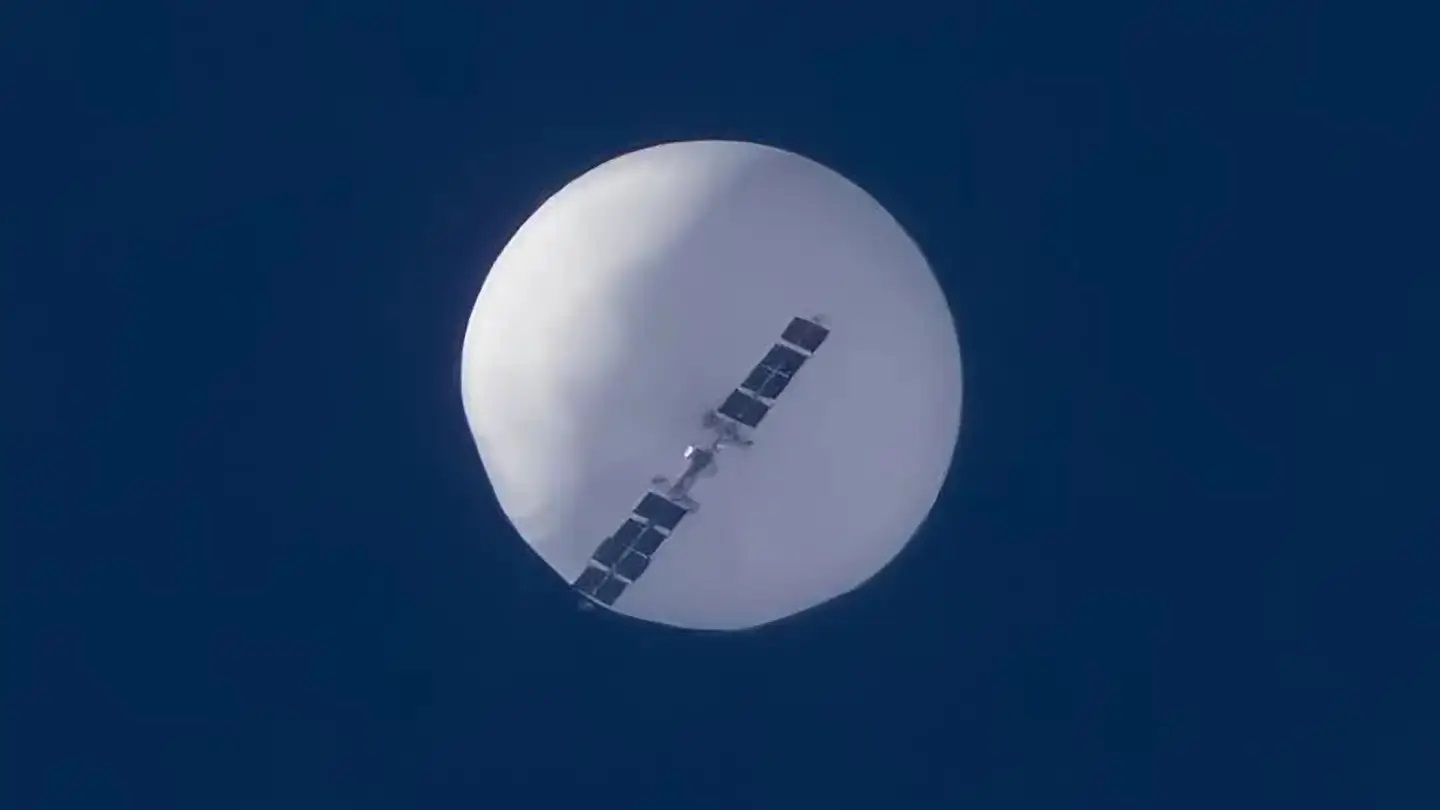
Since the final long-delayed downing of the Chinese Spy Balloon on February 4th, the Biden Administration directed the United States Air Force to shoot down three other “unidentified flying objects” also found in North American airspace; two in the US and one in Canada.
In what appears to be a rush to deflect from the fiasco of the Chinese Spy Balloon affair, Biden tried to show that he could fling missiles around with the best of them.
Hilarity ensued.
It was a mistake to not provide clear on-the-record information from senior officials during these events. Naturally, in the vacuum it created from its absence, the rankest speculation surrounded the "UFOs" (or the new government-coined phrase "unidentified anomalous phenomenon" that means UFO) with wild tabloid-press types of descriptions:
“No visible propulsion.”
“Don’t know how these things stay aloft.”
“They interfered with the fighter aircraft’s instruments.”
“US adversaries may have launched recent UFOs.”
Speculation ran so rampantly in the press, both old media and new, that even the high-ranking four-star Air Force General who commands the North American Air Defense Command (NORAD) wouldn’t discount the thought that they could be extraterrestrial in a televised press conference.
“Could aliens be the source of mysterious ‘objects’? NORAD chief hasn’t ruled out anything"
Now, let that soak in for a minute.
The story was that our military and civilian radars feeding into NORAD had been “improved” and recalibrated for slow-moving objects. In short, they turned up the gain and all of these UFOs popped out. “Oh my gosh, space invaders!” or “Those wily Chinese have invented a new type of aircraft!”
Both ideas were wrong.
There was a more down-to-Earth explanation. Anger toward the Administration came from both sides of the aisle; Democrats were almost as unhappy as Republicans. Trying to recover politically, the Biden Administration turned trigger-happy. “Shoot’em all down” became the orders of the day passed to the military.
After the downing of the Chinese Spy Balloon on February 4th, two additional F-22s and an F-16 were dispatched to three “UFOs” in three days (February 10-12) and used four of our most-advanced AIM-9x Sidewinder heatseeker missiles to shoot down these dangerous objects.
The February 10-12 period is now called the Balloon Panic of 2023.
Unfortunately for the Administration, the reality of what they shot down was just a tiny bit different. The operative word in that sentence is “tiny.”
At least two of the three were "pico balloons" with the word "pico" denoting "very small" or tiny. Pico literally means "one trillionth part of" or two orders of magnitude smaller than "micro" in the progression of milli > micro > nano > pico. Yes, "pico" is a bit of hyperbole, but definitely meant to imply "tiny" as in a three-foot diameter balloon; a Mylar party balloon just like you might buy at Party Bazaar rather than the multi-million dollar 200-foot diameter aerostatically-buoyant free-floating balloon represented by the Chinese Spy Balloon.
At least two of the objects shot down AFTER the spy balloon were pico balloons flown by US-based hobbyists on weather research missions.
Unlike the more well know latex weather balloons, pico balloons use Mylar or some other non-stretchable strong material. Whereas latex balloons ascend to their maximum altitude, stretching as they rise and then pop (usually in a few hours), pico balloons use different designs and materials to achieve long-duration flights. They are about three feet in diameter and filled with just enough helium to gain their maximum altitude and stop expanding. The envelope material is strong enough to hold that pressure (albeit small) without popping. A superpressure balloon is a simple non-extensible envelope capable of withstanding a differential of pressure, higher inside than out. It is inflated so that the smaller night-time pressure of the gas still fully extends the envelope. Such a superpressure balloon will keep an essentially constant level until too much gas diffuses out of it. The "superpressure balloon envelope" is filled with enough lifting gas to achieve neutral buoyancy at their operational altitude, typically 20,000 to 50,000 feet. As a superpressure ballon, they float at roughly a consistent altitude without having to vent gas or ballast; in other words, they have no need for expendables which is a good thing for long-duration flights. Wind currents, usually the jet stream, push them through the atmosphere. Pico balloons are easily capable of circling the Earth several times in long-duration missions before failing. They typically carry a 16-gram (approximately half-ounce) payload consisting of a couple of science instruments, a GPS tracker and a radio transmitter. Everything is miniaturized via the most advanced solid-state electronics and powered by tiny solar cells that produce just milliamps of power.
In two of the three cases, we know who built these pico balloons, where they were launched and when. We had good GPS coordinates for their flight paths. One was built and flown by the Northern Illinois Bottlecap Balloon Brigade and the other by Ham radio operator K9YO-15. Both flights were well documented, complete with GPS tracking data.
It has been reported that one was on its seventh circumnavigation of the globe after being aloft for 123 days.
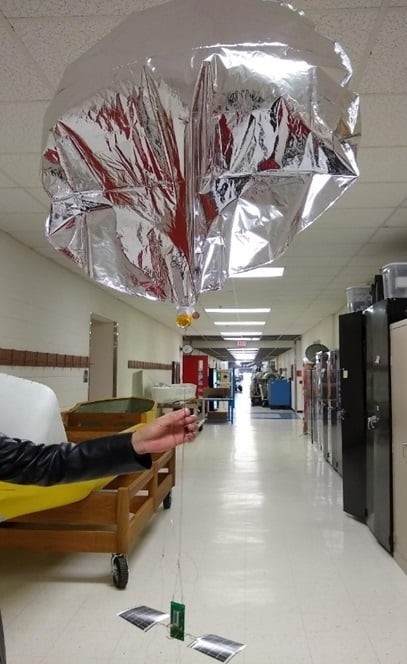
Above, is an unrelated pico balloon that was flown by the club at the United States Naval Academy in 2018.
Yes, they may look like “party balloons” and, in essence, they are; just better made and haul a very high-tech instrument “package;” albeit very small. The size and weight (the mass) of the package are important to the engineering and a big part of making this such a successful venture. All flight articles have to be incredibly light for a 32” Mylar constant-pressure balloon to carry them to 40-thousand feet (or up to 65-thousand feet with a slightly larger balloon.) You could put the whole payload package in a Number 10 business envelope and mail it with a single First Class stamp. But, in its advanced miniaturization, the flight article still collects its scientific data, its GPS position in three dimensions and reports it all as it travels as telemetry. Its very small solar panels provide enough milliamps of electricity to power the package for months without weighty batteries that don't operate well in the cold of the altitudes involved.
Valuable science can be collected but there are a lot of “smarts” in building the darn thing and a lot of fun in simply making and flying something that has the potential to circle the Earth several times.
This is a classic example of Occam’s Razor; which is the simpler, more plausible explanation: (1) space aliens with some unknown propulsion system, or (2) a three-foot helium-filled research balloon of US origin?
The smoking gun indicating that at least two of the three UFOs were pico balloons is that we have their reported position from their telemetry that reports onboard GPS positioning that is radioed to the tracking network that supports the hobby.
Although not commonly known, there is a small but very dedicated community of amateur hobbyists made up of Ham radio operators and high-altitude balloonists that handcraft small balloons and fly them. They have done so for decades. They are often organized into clubs and provide STEM education projects for school children. The balloons carry very small electronic payloads (designed and produced within the community) of just a few grams in weight that report temperature, atmospheric pressure and accurate 3D GPS locations to a global radio network that is reported and tracked to an international website open to all.
These amateur balloons supplement the 1,000+ “professional” radiosonde balloons that are flown EVERY DAY that collect the same type of data that is used to feed weather models. These radiosonde balloon flights usually last a few hours each. However, the amateur pico balloons are long-duration flights and often at much higher altitudes than the regular radiosonde flights. They serve a need that provides a mission objective for the hobby.
The high-altitude balloon hobby is divided into two parts: (1) the traditional latex weather balloon that goes up to the stratosphere, pops and comes back down on a parachute; a typical flight lasts several hours; and (2) pico balloons that go up to a certain height, stay relatively at that height (subject to some altitude fluctuation during the day as the sun heats things up) and get carried along in the prevailing winds aloft, usually the jet stream; they can stay up for months and the record is almost two years. Many of the latex balloon flights have radio and/or live video cameras transmitting on the Ham bands. Some just carry a GoPro camera to capture the video offline. All of the pico balloons have Ham involvement because the Ham license is needed to use the radios for the tracking and reporting network. Latex ballooning has been around for a long time but started in earnest after World War 2 because of all of the cheap Army-surplus weather balloons becoming available. Pico ballooning is only about 10-15 years old because micro-miniaturization and surface-mount integrated circuits became possible.
Pico ballooning is where the real interest is today because it is challenging and produces real science over a long duration.
What makes this a fun hobby is that there is a lot of science and engineering involved in building and flying these balloons as well as a lot of learned skills involved. A well-made Pico Balloon can circumnavigate the Earth multiple times. That’s right, these “party balloons” can circle the Earth multiple times and report its science all along the way!
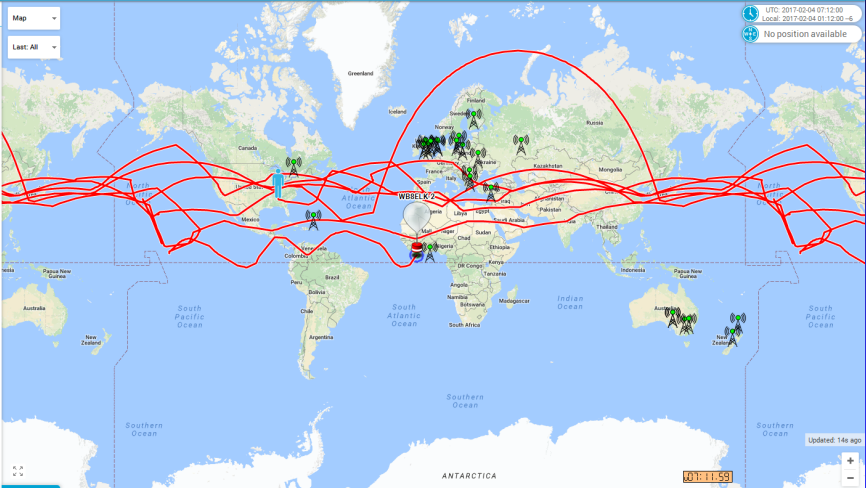
Above is the global track of Bill Brown's (WB8ELK) WSPR flight that went around the World over 6 times flying at 40,000 feet for 75 days.
See his excellent introduction to the hobby in his presentation at Ham Expo 2020.
The record flight duration of a pico balloon is 767+ days aloft circling the Earth 35 times!
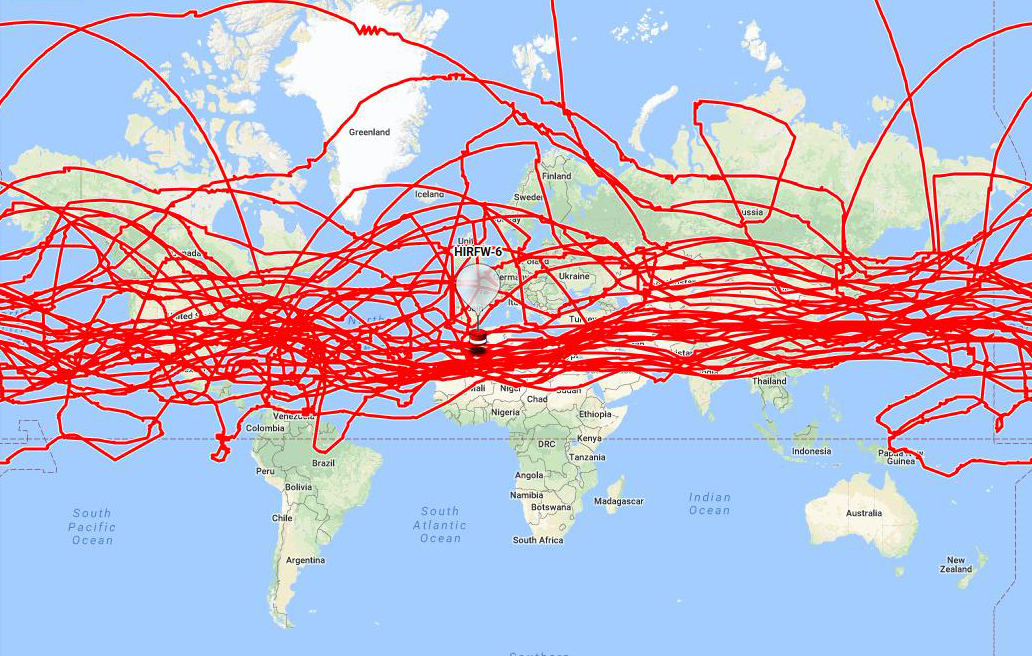
It is all done seriously. All of these hobbyist balloon flights are conducted under FAA regulations as well as an international treaty, the Chicago Convention of 1944. The Chicago Convention has since been revised eight times (in 1959, 1963, 1969, 1975, 1980, 1997, 2000 and 2006). As of March 2019, the Chicago Convention had 193 state parties as signatories, which includes all member states of the United Nations except Liechtenstein. The international balloon regulations can be found in the International Civil Aviation Organization, Annex 2 and Rules of the Air, Appendix 4, Unmanned Free Balloons.
In other words, hobby ballooning isn't just some folks freelancing all of this. There is a recognized foundation in both US and international law for these flights.
Hobbyists also file NOTAMs (“notice to airmen”) with the Air Traffic Control network of the FAA about their flight operations 24 hours in advance of launching.
As part of the hobby, these balloons are tracked and their telemetry is collected. The Ham radio community has developed a special long-range radio protocol called “WSPR” (pronounced “whisper”) that allows over-the-horizon long-range telemetry on the 20-meter HF (“high frequency”) Ham radio band that allows ground stations to track flights even when over the ocean and, at the same time, consumes very little power, only about 10-milliwatts. There is also a higher capacity channel on the 2-meter band that operates when the balloon in is the line-of-sight of a network node. The tracking network alone is a marvel. Also, part of the hobby, the tracking data is collected and reported from all over the world on an easily accessible website with a great international reputation. See https://sondehub.org/. The site operates in real-time and shows all balloons that are in flight from all over the world. The whole thing is financially supported by crowd-sourcing from within the hobby itself to make the resulting data freely available to all. The whole enterprise is amazing and shows what a group of dedicated hobbyists can do.
The balloons and their payloads are purposely designed and regulated to pose almost no threat to aircraft or people on the ground should the balloon fail. All of the largest hobbyist balloons package (envelope and payload) must weigh less than six pounds (the regulatory limit) and the pico balloons far less. No single item attached to the balloon package can weigh more than four pounds (the pico balloon payload is less than an ounce) and even the string that connects the instrument "train" under the balloon is engineered to have a low breaking strength if the balloon were ever to collide with an airplane. As a best practice, the largest balloons in the hobbyist class (still classified as "light" balloons in the regulations) with larger payloads (of a couple of pounds) have a parachute to lower the payload if the balloon pops and/or a radar reflector for radar tracking. In literally millions of these flights of hobby balloons or very similar professional radiosondes, no aircraft accident has ever been reported. Although they climb through air-traffic lanes in the brief climb-out stage to reach their operating altitude, and during their final terminal descent, these balloons spend most of the flight much higher than where airplanes operate. Even still, hobbyists still file NOTAMs with the FAA and air traffic controller divert any flights in the air lanes during ascent and decent.
By the way, this isn’t “big science.” Just the opposite, it is very "small science" but no less valid. The total cost of a flight is around $60, all in. The use of the tracking network is free.
At this price point, many small clubs in high schools can perform flights and learn a lot of good science and engineering along the way. They also can participate in, literally, a global endeavor. It is also very rewarding for school kids to see their hand-built airship fly across a continent or even a state. Around the world flights are often accomplished by kids.
In other words, these hobbyists are not a bunch of yahoos. Although strictly amateur, this hobby is serious, produces real science and helps kids learn STEM with exciting projects. Pico ballooning also involves a federally-issued Ham radio license. Their call signs are embedded in the telemetry stream so their call sign is broadcast for all to see; nothing stealth about a flight.
It is also a lot of fun. As you can perhaps tell, I have been personally involved in the hobby for a long time. I got my first Novice Class Ham radio license when I was 10 years old (WN5HMI) and after my schooling was finished, along with a cousin my same age and fellow Ham, operated one of the tracking stations in Fort Worth for several years including real-time amateur TV from latex balloons.
All good clean fun with a bucket full of real science in the endeavor thrown in for good measure.
Now, herein was a major predicament of the Biden Administration. They were so anxious to demonstrate their butch-ness on national security matters after the embarrassment of their failure to take down the Chinese Spy Balloon, they started issuing a lot of commands to the very serious people who operate our advanced weapons systems. In the haste to do something (when they finally decided to), nobody at NORAD, the Air Force, or the White House bothered to check the website (https://sondehub.org/ ) that would have shown the real-time tracks of these hobbyist balloons. In a double failure, nobody bothered to check the separate "notice to airmen" (NOTAM) system either. I doubt that anyone in or near the White House even knew that pico balloons were a thing. Much less an old and honored hobby that also included STEM education aspects.
Strictly speaking, this was not the "domain awareness gap" NORAD talked about in the Chinese Spy Balloon portion of the whole affair. The data about pico balloons existed, they had access to it (it is all open source in the public domain) and some of it (the NOTAM notices) were always in government computers at the FAA. They just never looked. If their radars recently improved and now can show slow-moving 32-inch party balloons drifting in the jet stream, checking for balloons is something their daddies did and no longer done by this generation. From the comments made by senior Administration officials about altitude and operating lights, it was clear nobody in the Biden administration even knew about small balloons exempted by both the FAA and the international Chicago Convention of 1944.
Yep, a blind eye was turned.
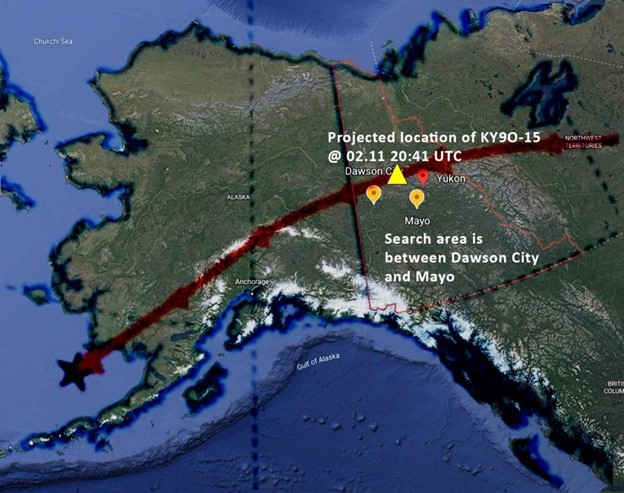
The flight path of the KY90-15 pico balloon before its loss of signal.
And then, the beclownment began.
As a result, more than a half-billion dollar worth of high-tech fighter aircraft (not counting support aircraft such as tankers and even AWACs included in the missions) was sent to shoot almost $2 million worth of our most advanced Sidewinder missiles to take out what was, in essence, $180 worth (combined cost) of harmless “party balloons” on a real science mission.
We don’t yet know about the third object. But the other two shoot-downs of pico balloons are pretty well documented because of their tracking.
This “Great Biden Balloon Beclownment” came about because, for some inexplicable reason, the administration couldn’t find a suitable unoccupied spot in the Aleutian Islands, Alaska or Montana to shoot down the spy balloon, although the government had been tracking it for two weeks BEFORE it got to the Aleutians. Instead, they let this huge, highly-visible aircraft float over the entirety of the continental United States.
This, along with the political blowback, created the context for sending our best fighter jets after pico balloons.
Please note that the Chinese Spy Balloon was NOT a pico balloon. Far from it and on the opposite end of the scale. The spy balloon envelope was 200 feet in diameter. Its payload was over 2,000 lbs. Its solar array could produce over 1.5 kilowatts of power. It was festooned with radio antennae and receivers for collecting signals intelligence and contained downward-looking cameras for capturing images. It also could change altitude to catch winds from different directions so it could loiter (station-keep) over an area of interest; which it reportedly did near our strategic military bases in Montana (the ones with the ICBM silos.)
This was no “weather balloon” as China maintains. The FBI now has the payload that was recovered from the shoot-down, so we will have more information in the near future.
The Chinese Spy Balloon rightly should have been shot down, just a heck of a lot sooner.
The Biden Administration BADLY misjudged the public reaction to its inaction. With their egos bruised, their pendulum swung so far in the other direction that it used some of the most sophisticated military hardware to take out what was, in essence, a mylar party balloon filled with helium and dangling a radio.
This also perhaps explains why the Biden Administration has been so tight-lipped about the whole affair. There is no reasonable explanation that doesn’t make them look incredibly foolish. The failure to take down a spy balloon loitering over was pretty bad on its face. Waging war on party balloons, however, sank to the level of theater of the absurd.
Texas Senator Ted Cruz joked on Twitter, "To be fair, Biden is providing a powerful deterrence for any high school science clubs that might try to invade America.”
You just can’t make this stuff up. If it wasn’t so serious, this would be hilariously funny.
The whole affair also provides a moral to the story, an object lesson: it is far better to elect smart people to office who can surround themselves with even smarter people who can take care of national security matters when the shooting starts.
POTUS and a very big part of his administration don't appear to be able to meet these criteria.
UPDATE: Reality seems to be setting in. The US Nothern Command (NORTHCOM) called off the search for two of the "objects."

Update - 2/20/2022: It looks like the Balloon Panic of 2023 has ended. The hobby looked on with great interest yesterday to see if two amateur pico balloons would go unmolested as they crossed the US border in their transit of US air space on their trips around the world. Yes, both comply with the Chicago Convention of 1944 for international flights just like the two that were shot down.
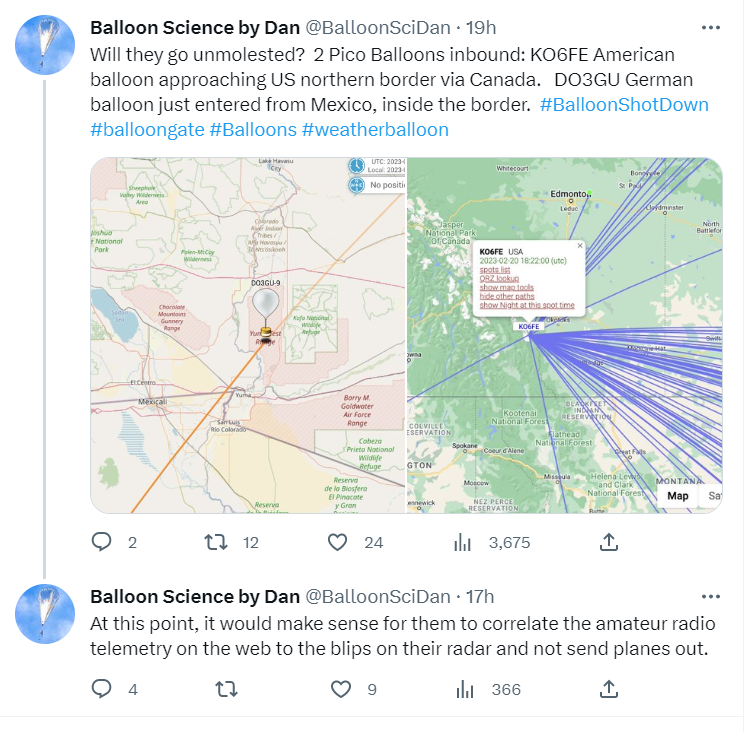

| 1 Comment | Add Comment |